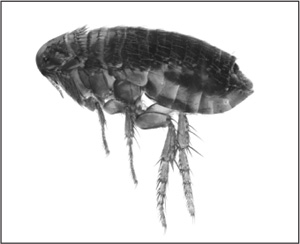Animal BehaviorBehavior of Animals in Motion |
How do fleas jump so far? |
The jumping power of fleas comes both from strong leg muscles and from pads of a rubberlike protein called resilin. The resilin is located above the flea’s hind legs. To jump, the flea crouches, squeezing the resilin, then it relaxes certain muscles. Stored energy from the resilin works like a spring, launching the flea. A flea can jump well both vertically and horizontally, which is why they are able to attach themselves so readily to not only our pets, but to us. In fact, some species can jump 150 times their own length! To match that record, a human would have to spring across the length of two and a quarter football fields—the height of a one hundred-story building—in a single bound. The common flea (Pulex irritans) has been known to jump 13 inches (33 centimeters) in length and 7.25 inches (18.4 centimeters) in height.

The flea’s remarkable hind legs can produce a powerful burst of energy by using a rubber-like protein called resilin.
